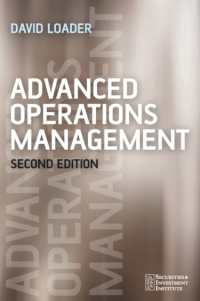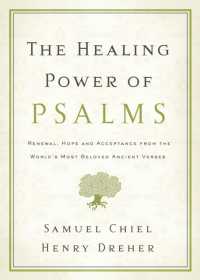Full Description
Using classroom discussions to teach good habits of thinking
Classroom discussion has a major effect on student learning. In fact, dialogue is one of the best vehicles for learning how to think, make moral decisions, and understand another person's point of view. Research also indicates that most teachers talk too much in the classroom and don't wait long enough for students to respond. How do we improve the quality of classroom discussion? Challenging Learning Through Dialogue transforms the most up-to-date research into practical strategies that work. Readers will learn
How to build in more "wait-time" for better quality thinking and questioning from students
How to use dialogue to teach reasoning, collaboration, and good habits of thinking
The three types of dialogue and how to teach the most effective version: exploratory talk
Dozens of practical strategies for exploratory dialogue
Global examples of fun ways to teach dialogue
An innovative new instructional strategy called Classroom Mysteries
Written by an internationally known team of educational innovators, this book is for all educators who aim to use effective classroom dialogue to engage students in learning.
"This valuable book is a must for teachers and families who wish to have their children learn to think and communicate with greater precision and clarity."
Arthur L. Costa, Ed. D., Professor Emeritus
California State University Sacramento and Co-Director, International Institute for Habits of Mind
"James Nottingham's work on Challenging Learning is a critical element of creating Visible Learners. This new series will help teachers hone the necessary pedagogical skills of dialogue, feedback, questioning, and mindset."
John Hattie, Professor & Director, Melbourne Education Research Institute
University of Melbourne
Contents
List of Figures
The Challenging Learning Story
Foreword by Guy Claxton
Acknowledgements
About the Authors
Contributors
Introduction
The Language of Learning
Chapter 1: Why Dialogue?
1.0 Why Dialogue?
1.1 Reasons for Dialogue 1: Learning How to Think
1.2 Reasons for Dialogue 2: From Surface to Deep
1.3 Reasons for Dialogue 3: Creating a Climate of Trust
1.4 Reasons for Dialogue 4: Developing Languge to Express Understanding
1.5 Review
1.6 Next Steps
Chapter 2: Dialogue Essentials
2.0 Dialogue Basics
2.1 Putting Dialogue in the Context of Educational Objectives
2.2 The Hidden Classroom
2.3 Active Engagement
2.4 Conditions for Successful Dialogue
2.5 Language for Dialogue
2.6 Exploratory Talk
2.7 Review
2.8 Next Steps and Further Reading
Chapter 3: Dialogue to Engage Students
3.0 Preview
3.1 Getting the Ethos Right
3.2 Issuing Invitations
3.3 Encouraging and Engaging
3.4 Restating
3.5 Reformulating
3.6 Review
3.7 Next Steps and Further Reading
Chapter 4: One Way to Learn How to Think: Develop Reasoning
4.0 Preview
4.1 The Language of Reasoning
4.2 Developing the Language of Reasoning
4.3 Process of Reasoning
4.4 Routines to Develop Reasoning
4.5 Developing a Reasoning Repertoire
4.6 Reasoning Moves
4.7 Review
4.8 Next Steps
Chapter 5: Dialogue Groupings
5.0 Preview
5.1 Dialogue Groupings
5.2 Ground Rules for Dialogue Groups
5.3 Whole-Group Dialogue
5.4 Splitting Large Groups Into Two
5.5 Small-Group Dialogues With a Teacher
5.6 Small-Group Dialogues Without a Teacher
5.7 Final Word About Groupings
5.8 Review
5.9 Next Steps and Further Reading
Chapter 6: Dialogue Detectives
6.0 Preview
6.1 Appointing Dialogue Detectives
6.2 Clues to Detect: Focusing on Performance
6.3 Clues to Detect: Focusing on Thinking Structures
6.4 Other Clues to 'Detect'
6.5 Review
6.6 Next Steps and Further Reading
Chapter 7: Dialogue Structures
7.0 Preview
7.1 Paired Dialogue
7.2 Opinion Lines
7.3 Opinion Corners
7.4 Choosing Corners
7.5 Talking Heads
7.6 Jigsaw Groups
7.7 Clustering
7.8 Review
7.9 Next Steps and Further Reading
Chapter 8: Mysteries
8.0 Preview
8.1 Mysteries
8.2 Running a Mystery
8.3 Mysteries in Practice
8.4 Questioning Cause and Effect Within Mysteries
8.5 Reviewing a Mystery Using the SOLO Taxonomy
8.6 Writing Your Own Mysteries
8.7 Review
8.8 Next Steps and Further Reading
8.9.1 Mystery: Should Bjørn Move to France?
8.9.2 Mystery: Louis Pasteur and the Anthrax Vaccine
8.9.3 Mystery: Is Sally a Good Friend?
Chapter 9: Odd One Out
9.0 Preview
9.1 Odd One Out
9.2 Benefits of Odd One Out
9.3 How to Use Odd One Out Effectively
9.4 Why and When to Use Odd One Out
9.5 Odd One Out Variations
9.6 Odd One Out Examples
9.7 Extending Odd One Out With Venn Diagrams
9.8 Review
9.9 Next Steps and Further Reading
Chapter 10: Fortune Lines
10.0 Preview
10.1 Fortune Lines
10.2 Using Fortune Lines
10.3 Fortune Line of Henry VIII
10.4 Fortune Line for a Visit to Grandma's
10.5 Review
10.6 Next Steps and Further Reading
Chapter 11: Philosophy for Children (P4C)
11.0 Preview
11.1 Philosophy for Children
11.2 The Community of Inquiry
11.3 Philosophical Questions
11.4 Dialogue Through P4C
11.5 P4C Sequence—Overview
11.6 P4C Sequence—In Depth
11.7 Review
11.8 Next Steps and Further Reading
Chapter 12: Dialogue Exercises in P4C
12.0 Preview
12.1 Dialogue Exercises
12.2 Make a Choice, Give a Reason
12.3 Concept Stretching: Fairness
12.4 Review
12.5 Next Steps and Further Reading
Appendix 1. Dialogue Detectives
Appendix 2. Louis Pasteur Script
Repertoire and Judgement Notes
References
Index








